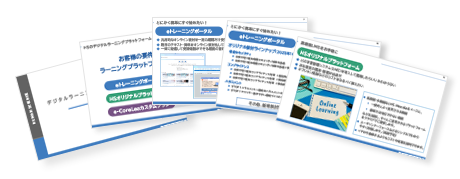2021.01.12
How to Create e-Learning Materials Part 3: Video Format
PreviousContinuing from last time,
・I want to challenge education through e-learning, but I don't know where to start.
・I want to create the teaching materials in-house as much as possible.
We will explain about educational material production to the education personnel who are considering it.
In the first session, we explained about "3 formats of e-learning".
1.Animation (html5 format)
2.Video format
3.PowerPoint, PDF
This time, we will explain the overview and production method of "video format" teaching materials.
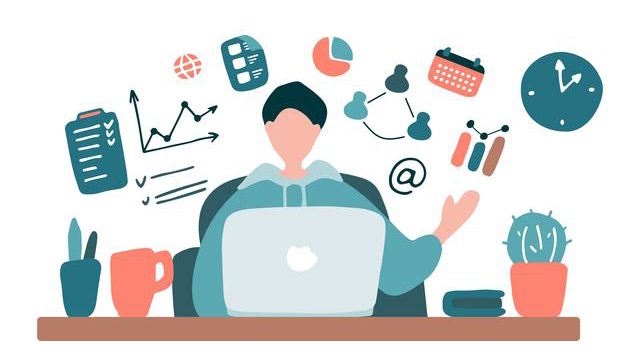
1. Types of Visual and Video Learning Materials
The videos used in e-learning are classified into four types.
1. Training videos
2. Interpersonal skills learning videos
3. Technical training videos
4. Others
1. Seminar Videos
This is a teaching material created by taking pictures of instructors actually conducting training and using materials for lectures.
The most common format is to show both the instructor and the materials related to the explanation on the same screen.
In the classroom, the instructor will use a whiteboard to give lectures, but in e-learning, the instructor and materials on the screen will be used to progress learning instead.
2. Interpersonal Skills Learning Video
This is a video learning material suitable for learning sales know-how and human skills.
Actors and related personnel will appear and progress based on the script. By actually seeing the communication taking place, it visually conveys points that are difficult to convey in writing.
3. Technical Training Videos
This is a suitable teaching material for understanding and learning how to use equipment and technology.
By using live-action, the actual movements of the equipment and the operator's hand movements can be accurately conveyed without any misunderstandings.
4. Others
Other formats include those that do not fall under the above three categories. These may include interview footage and introduction videos for facilities and equipment.
2. Process for Creating e-Learning Materials in Video Format
The process of completing e-learning materials in video format is as follows:
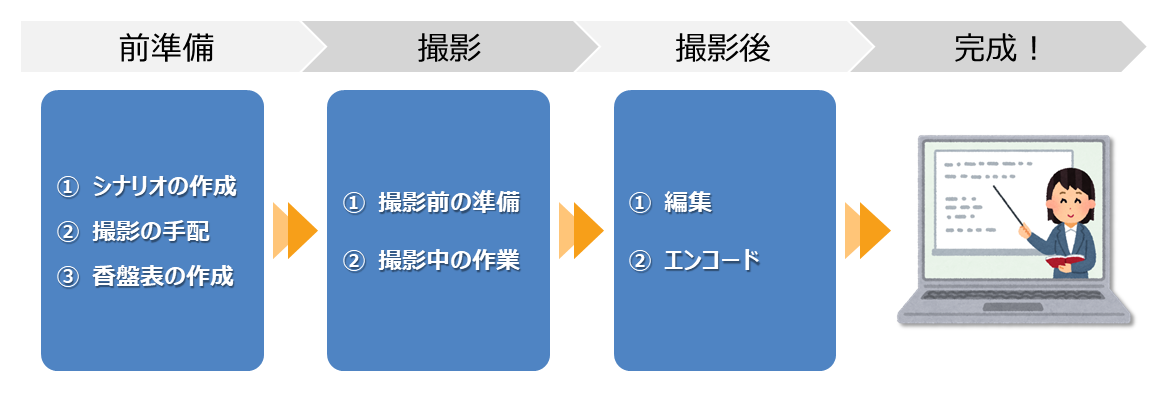
Step1. Create Storyboard
The storyboard for filming is a representation of the completed educational material in images.
It is composed of screen images and narration.
During filming, it is necessary to include the necessary information so that the camera crew, staff, and actors can share the final image, and during editing, the editing staff can share the final image.
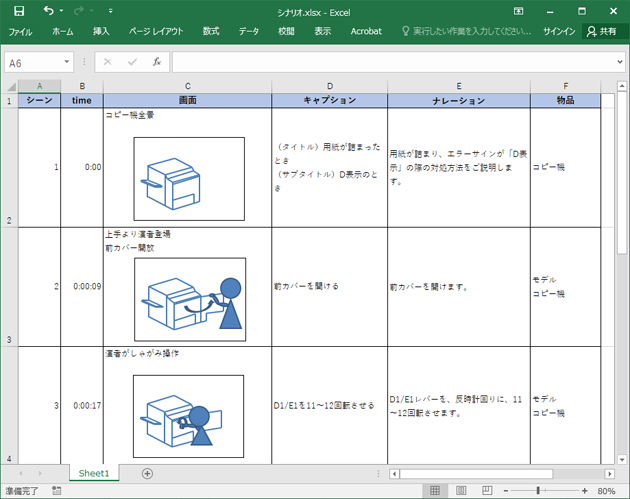
Storyboard Image
Step2. Consideration of performers and shooting locations
We will consider the performers and shooting locations. We will also create a "cast list" (koubanhyou) that summarizes the shooting arrangements.
As for the performers, when arranging professional actors, we will inform the production company based on conditions such as age and gender, and adjust the schedule. Selection may involve choosing from multiple candidates or holding auditions.
If the shooting location is outside the company, it may require prior permission, so caution is necessary.
Also, if possible, we will conduct a location hunt and confirm the setup of equipment and camera angles on the day of shooting. By conducting a location hunt, we can consider the shooting positions for each scene in advance, making it possible to efficiently proceed on the day of shooting.
"Shot List" is a document that summarizes the shooting arrangements.
For example, there are cases where the scenes are limited to only the beginning and end of the video for certain actors. In such cases, if the shooting is done according to the story of the video, it will be inefficient.
The shot list is a consideration of the shooting order in order to efficiently shoot.
In addition to the actors, it is also assembled taking into account costumes, props, and screen backgrounds.
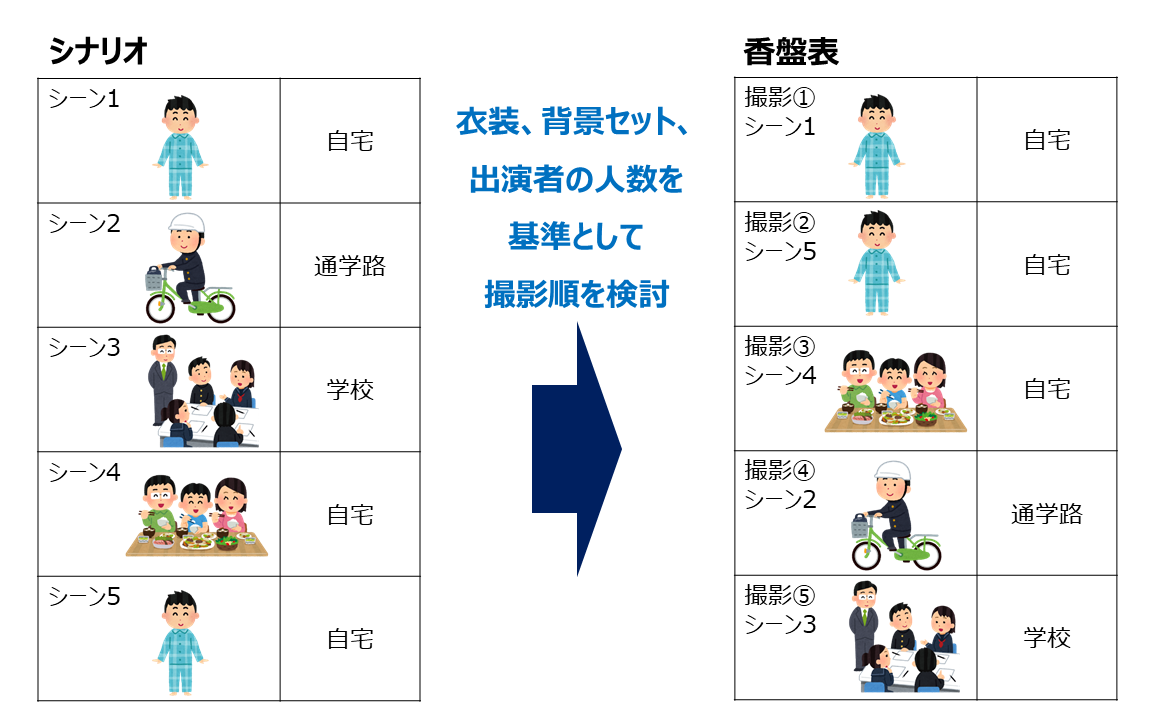
Step3. Arrange for filming
During the final stage of preparation, we will make arrangements necessary for filming.
We will arrange equipment and staff.
We will secure cameras, lighting, props, audio recording equipment, and staff responsible for each.
If using external resources, we will arrange through specialized vendors or leasing companies.
Depending on your budget and desired quality, there may be cases where you can use a home video camera or smartphone to film.
Even if the filming is done only by internal staff, let's prepare the necessary personnel and equipment based on the shooting schedule.
Note: When creating 4K, 8K, VR, etc., compatible equipment is required.
If actors or narrators are needed, they will be officially arranged at this time.
When taking photos of outdoor areas or buildings, don't forget to apply for permission to take photos.
It may take some time for the permission to be granted, so we recommend applying early.
In addition, when bringing equipment such as cameras to the shooting location, there may be a separate application required in addition to obtaining permission for filming. Please be sure to confirm this.
Step4. Shooting
On the day of the shoot, we will have a meeting and rehearsal with all the people involved, including the performers, before proceeding with the filming.
The most important thing in filming is to avoid missing any shots. Even if we try to fix it in editing, there are limitations, so we will make sure to determine whether a take is good or bad and proceed with the filming accordingly.
If there are any missed shots, we will have to do a reshoot.
Step5. Edit
There are two types of editing: "rough editing" and "final editing".
"In the rough editing process, the overall structure and flow are finalized.
NG takes are cut and each scene is rearranged in order according to the scenario.
We check to make sure there are no unused NG takes, no missing scenes, and no other editing mistakes.
If there are no issues, we move on to the final editing process."
"In the main editing process, we will adjust the sound quality and volume, add effects for scene transitions, and correct color tones."
Step6. Narration Recording
There are two ways to add narration to a video:
・Record the narration first and synchronize it during video editing
・Edit the video first and record the narration to match the video
If recording narration first, it is necessary to adjust the video to match the length of the finished narration audio.
If you are doing video editing first, record the narration while playing the edited video. This type of recording is called ADR (Automated Dialogue Replacement).
If you choose to use a professional narrator, this method is recommended.
The narration text should be finalized when creating the storyboard, but changes and revisions are almost always necessary during the process.
Therefore, it is best to record the narration as close to completion as possible, but on the other hand, the presence or absence of narration can drastically change the impression of the video.
Therefore, we recommend using temporary narration. Temporary narration is recorded using a computer or voice recorder. Until the final narration is recorded, the video is checked with the temporary narration to prevent any discrepancies in the final image.
It is okay if there is noise in the temporary narration, but the speed and timing of the reading should be conscious of the final version.
Step7. Encode
Once editing is complete, we will perform encoding to finalize the video.
Encoding in video editing refers to the process of compressing and converting the video into formats such as mp4 or wmv for export.
Once encoding is complete, play through it once to check for any significant issues such as missing parts.
If there are no problems, then it is complete.
Once the materials are completed, they can be distributed (distributed) to the learners and learning can begin.
If using an LMS, format and register the materials. If not using an LMS, prepare and notify according to the distribution method.
Author:
Shizuko Sase
Education Solutions Department Production Group Writer
After joining Human Science, worked as a Technical Writer,
experienced in designing and writing product manuals and operation manuals.
Subsequently, engaged in writing and directing e-learning material manuscripts.
Involved in the production of approximately 200 educational materials so far.
Contact Us:
Phone Number: 03-5321-3111
hsweb_inquiry@science.co.jp
No Failure! How to Create e-Learning Video Materials
~Technical Training Video Edition~
We will explain the features and creation methods of technical training videos in e-learning video materials. We also include common points in video production.
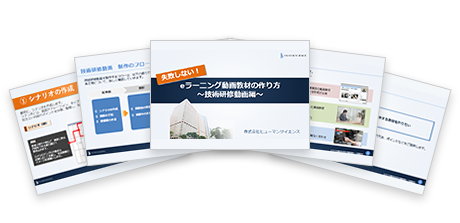
【Content】
Technical Training Video Production Flow
1. Preparations (① Scenario Creation, ② Shooting Arrangements, ③ Storyboard Creation)
2. Shooting Day (① Pre-Shooting Preparations, ② Shooting Tasks)
3. Editing Work (① Editing, ② Encoding)
Latest Blog
- 2024.04.02
- English Learning Using Moodle and ChatGPT












